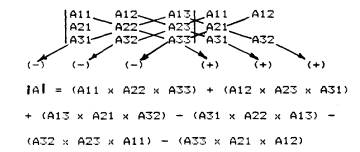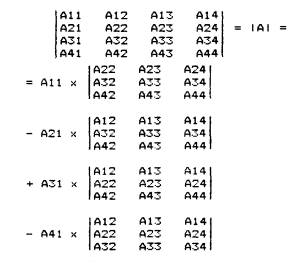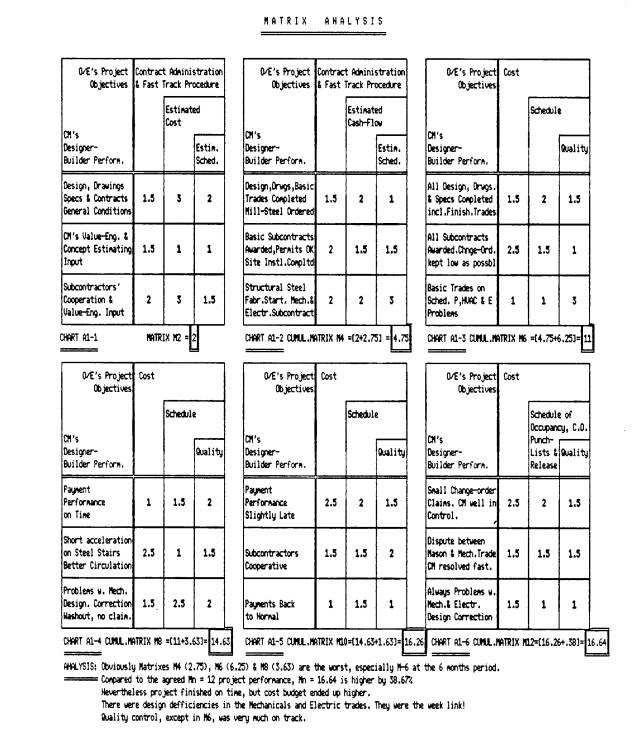(pressing HOME will start a new search)
- ASC Proceedings of the 28th Annual Conference
- Brigham Young University-Provo, Utah
- April 18-20, 1991 pp 83-86
|
(pressing HOME will start a new search)
|
|
MATRIX EFFECTIVENESS REVIEW TECHNIQUE (MERT) A TOOL FOR CONSTRUCTION MANAGEMENT
|
| A
matrix in construction management could be defined as a set of objectives
to be regularly reviewed, monthly, bi-monthly, or quarterly for the
purpose of setting priorities, reevaluation, and progress performance, by
interfacing the Owner/ Entrepreneur's (0/E) objectives with the
organizations which produce the stages of planning, design, execution of
quality construction, namely Architects/Engineers (A/E), Construction
Managers (CM), General Contractors (GC), or even large basic
Subcontractors (Sub) or Primes. Objective
setting could be a procedure of ratings on a scale from 1 to 5, whereby 1
= excellent or 100'%. effective and 5 = failure or completely unacceptable
performance for each time-set period, as it may be. These
matrixes can be calculated either by the O/E or the CM. In either case.
the approach to the rating system must be absolutely unbiased, reflecting
entirely the occured facts. Perhaps the calculation should be done by both
parties and an average between the two could be a fair evai,aati on. As
a point of reference, a meeting of the minds between O/E and CM should
produce an agreed ideal number for each period, which in cumulative
sommation for all periods will reach a total ideal number representing
in advance, before the project starts, the thriving goal. Any resulting
number equal or slightly lower, will demonstrate the effectiveness of the
whole integrated project performance. If the cumulative point sommation
over the time periods is much higher compared to the ideal, the project
has gone off the track,it derailed, it soured, it became tardy, and its
cost or expenses were much higher than estimated. If
this ideal number or any variations thereof up or down, within reasonable
limits, can be made integral part of a GMC (Guaranteed
Maximum Cost) contract agreement between O/E and CM, besides the CM's
agency, barring or disclaiming any extraordinary larqe or affecting
change-orders, the unrehearsed performance of all phases of a construction
project could eventually become a contractual quasi-guaranteed task..
RATING SYSTEM The
system of interfacing O/E's project objectives with ;CM-A/E's building
performance is rated from _1 to 5 for each interfaced or independent
activity in a matrix: 1 meaning perfection and 5 meaning failure. Since
construction is a sequential series of unrehearsed activities, a rating of
1, meaning absolute perfection is unlikely and improbable, thus, the
following scale of ratings for each interfaced objective versus building
performance could be summarized as follows: 1.0........
per-Feat performance (improbable)
1.5........ good performance 2.0........
acceptable performance 2.5........ acceptably mediocre performance
3.0........ viably poor performance 3.5........ viably very poor
performance 4.0........ unacceptable performance 4.5........ managerially
failed performance 5.0........ disastrous performance necessitating
substitution of managerial
skills In-between
interpolations could be very acceptable. |
ALGORITHMIC
MATRIXES
These
matrixes are represented by algebraic determinants. Barring any onerous
calculations, the 3 :: 71 determinant matrix is sufficient for lay people, given
the easy algorithm of solution reproduced herein. A 4 x 4 determinant matrix
would be a tremendous refinement in "long-hand". Once the needed
refinement is over 4 x -4, a
mathematical
computer software tool becomes a real necessity.
To
translate the whole matter into simple mathematical language, coe could state
that if the CPM or PERT schedule meganetwork shows a completion time for a
construction project in "n" time periods, a cumulative matrix
determinant value of
![]()
will
evaluate the efficiancy and effectiveness at the end of each time period, until
"Mn" would represent total cumulative matrix value upon completion, or
the number set by O/E and CM.
A
:a
determinant matrix can be represented thus:
![]()
The
numbers after each element represent the row and the column respectively.
To
resolve numerically the 3 x 1 determinant matrix, the following easy algorithm
may be used:

When
the determinant matrix is a 4 x 4, it may
be reduced to a 3 x ? or various 2 x _2. For that, one must brush-up on
elementary Algebra. Following equations depict the solution of a 4 x 4
determinant:

ILLUSTRATIVE
EXAMPLE
Let
us take the following example on a 2month evaluation frequency period for each
matrix determinant. The project is to last 12 months or 6 periods; first 2
periods are planning stages and last 4 are construction stages at jobsite.
The
ideal reasonable "negotiated" cumulative number to thrive for agreed
between O/E and CM is Mn = 12 upon completion.
In
case of a larger job, lasting 2 years for example, if the evaluation frequency
period for each matrix determinant is taken on a monthly basis, the reasonable
negotiated cumulative number could be between a minimum of 24 x 1.75 = 42 or a
maximum of 24 x 2 = 48. Any final result upon completion between 42 and 48,
would complement a GMC as a definite guarantee to the O/E by the CM.
IMPORTANT
COMPUTATION RULES
(1)
If all rating numbers in a matrixdeterminant are the same, the determinant =
O, which is absurd and impossible regardless of any applied rating, since
"O" would enhance the cumulative final rating fictitiously and
ineffectively, which could be considered as "cheating" the process.
(2)
Ignore any negative (-) result of any partial determinants in the cumulative
process; assume all determinants to be positive (+) in their cumulative periodic
sommation.
(3)
The final cumulative ideal rating number must be:
(a)
function of the project duration; (b) frequency function of matrix computation
for any repetitive time period;
(c)
a mutual agreement as to final rating-goal-number between O/E and CM-A/E (both
O/E's agents, even when CM is also designerbuilder CD/B/CM7, not or at risk
without or with a GMC);
(d)
a rating-goal-number under contractual obligation, especially if a GMC at risk
is involved.
PRACTICAL
CONCLUSION
Besides
the "at risk" GMC, the above could be used as a marketing tool by the
CM, to "sweeten" the contractual fee agreement upwards by perhaps
another percentage point.

ACKNOWLEDGEMENTS
For
computations of more than 2 x determinants, we recommend the use of MATRIX
MASTER, Clark Kimberling Mathematics Software Co.,419 S. Boeke Rd., Evansville,
IN 47714, (912^)479-6665. It can solve determinants up to 30 x 30.
REFERENCES
Project
Management, A Managerial Approach: -nd Ed.
by J. Meredith & S. J. Mantel Jr. J. Wiley & Sons, Publ.
Economics
of Building: R. Johnson, J. Wiley S Sons, Publ.